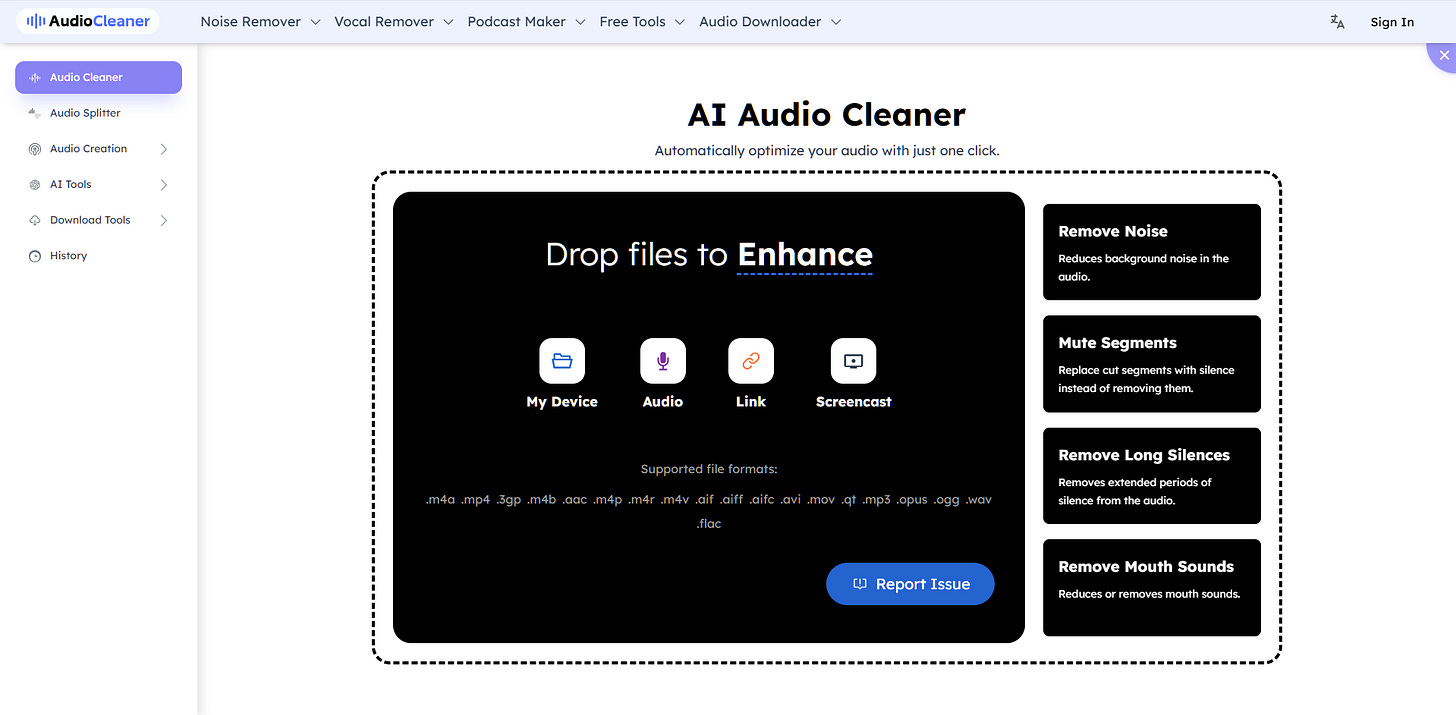14 Niche AI Tools You Should Try
They deserve a chance in the limelight.
We all know the key players in AI and are at least familiar with the big, mainstream AI products.
Hell, I have my own regularly updated list here:
But there are thousands of lesser-known AI-powered tools that do a specific thing or solve a niche problem.
So for this listicle, I dug up 14 of them that might be worth a look.
Let’s roll!
14 niche AI tools
All of the tools are free to use or at least free to try.
Here they are in alphabetical order:
1. AudioCleaner
Remove unwanted elements from audio clips
Got a poor audio recording with lots of background noise, awkward pauses, and filler words? Throw it into AudioCleaner to fix it up. At least in theory. In my one-off test, AudioCleaner did a solid job removing the noise and normalizing volume, but some pauses and filler words remained.
AudioCleaner also lists dozens of additional audio-related features like a voice extractor, translator, etc. It’s free to try, so give it a shot!
2. Calligrapher
Turn typed text into realistic handwriting
This one’s pretty straightforward: Type a line of text, then click “Write” to get a handwritten version. You can control the text legibility, stroke width, style, and more.
I like that each time you click “Write,” the handwritten version is truly regenerated from scratch, so no two rolls will look quite the same. The main downside is that you’re limited to 50 characters of text. You can also download the handwritten version as an SVG file with one click.
3. Explainpaper
Make research papers easier to digest
On the surface, Explainpaper looks just like any classic “Chat to PDF” wrapper. But it has a cool trick up its sleeve: Highlight any section of an uploaded research paper and have it explained in context. You can also adjust the explanation for any comprehension level.
And yes, it does have the typical chat function that lets you ask AI about PDF contents.
4. Fontjoy
Find font combos that work well together
This one’s great for people with design blindness like myself. Click “Generate” to roll a trio of fonts that look good together. If you find a font you like, you can lock it and roll to find complementary ones.
There’s also a slider to adjust how similar the rolled fonts should be. It’s a low-effort way to test drive font combinations for your slide decks, brand elements, and more.
5. Huemint
Preview color palettes on visual mockups
Another great tool for the design-challenged among us. Huemint rolls combinations of colors and immediately maps them onto preset visual mockups, including products, gradients, logos, UI elements, and more.
You can even upload your own image and apply the chosen color palette to it. Handy!
6. Khroma
Create endless palettes from your preferences
In contrast to Huemint’s random roll approach, Khroma is much more involved. It asks you to handpick 50 colors you like. (Yes, it takes a while.)
Khroma then trains a model on your selection, so it can spit out infinite palettes tailored to your preferences. I liked that it proactively suggested picking some brighter colors when it noticed that most of my first 20 picks were variations of “dark blue.”
7. Namelix
Brainstorm catchy brand names and logos
Super simple way to get tons of ideas for your business or brand. Plug in a few keywords, adjust optional settings like randomness, and watch Namelix spit out dozens of options. Each name comes with a logo mockup that might kick-start your imagination.
8. Patterned
Turn prompts into seamless repeating patterns
Need a repeatable design for something like tiles or wallpaper? Start here.
Describe your design and watch Patterned generate a seamless tiled pattern based on it. Sure, you can do this natively in something like Midjourney, but having a dedicated tool is quite convenient.
Patterned can also remix or fix existing patterns, work with uploaded images, apply your patterns to mockups, and more.
9. Podwise
Understand podcasts better with AI
In short, this is an AI companion for your podcasts. Find an episode you want to understand, then Podwise will pull up a transcript, key takeaways, and more. Podwise can also create mind maps and highlights for podcasts to help you synthesize information, much like NotebookLM.
You get a few free monthly credits to test it out, so give it a shot.
10. Real Or Fake Text
Can you learn to spot AI writing?
The premise is straightforward: You’re shown a sentence from a short story, recipe, speech, and so on, and then you have to guess whether it’s been written by AI or a human.
You’ll likely find out that you’re not nearly as good at reliably spotting AI writing as you might think. Give it a go!
11. Signs
Learn sign language in a hands-on way
This site teaches you the basics of American Sign Language via your webcam. It’ll detect the motion of your hands as you try to mimic the signs and give you feedback.
You can optionally submit recordings of yourself doing different signs to help train the next iteration of the model.
12. Trace
Map a screenshot to an anime show
The main purpose of this site is to help you find out which anime show a specific screengrab comes from. Simply upload the screenshot or provide a URL, and Trace will instantly identify the most likely matches.
But I found it fun to upload my own, non-anime images and see the closest matching visuals. This could be useful for creative AI video projects with transitions between the first and last frames.
13. Vidvoi
Auto-narrate your video clips
Use this to generate a voiceover for your videos. Once you upload a clip, Vidvoi analyzes it, writes a fitting script, and adds an AI narration.
You’re limited to 90 seconds per upload, so the most likely use cases are YouTube Shorts or TikTok promos.
14. Vocal Remover
Separate music from vocals
We’ve come full circle. Unlike the AudioCleaner, which enhances voice recordings by removing noise, Vocal Remover splits songs into separate vocal and music tracks.
But the site also has several other AI tools, including a pitch changer, BPM finder, audio track joiner/splitter, and others.
🫵 Over to you…
Did any of these tools catch your eye? Which of them do you see yourself using? Which lesser-known AI tools would you add to the list?
Leave a comment or drop me a line at whytryai@substack.com.
Thanks for reading!
If you enjoy my writing, here’s how you can help:
❤️Like this post if it resonates with you.
🔄Share it to help others discover this newsletter.
🗣️Comment below—I love hearing your opinions.
Why Try AI is a passion project, and I’m grateful to those who help keep it going. If you’d like to support my work and unlock cool perks, consider a paid subscription:














![Your search image Searched 1,526,053,026 frames in 0.23s 探偵学園Q Episode 8 00:05:07 - 00:05:10 ~68.63% Similarity 兄に付ける薬はない!2 Episode 13 00:01:22 ~67.36% Similarity テニスの王子様 Episode 60 00:16:24 - 00:16:26 ~66.69% Similarity テニスの王子様 Episode 23 00:06:36 - 00:06:37 ~64.76% Similarity テニスの王子様 Episode 79 00:14:24 - 00:14:26 ~63.41% Similarity [Tantei Gakuen Q][08].mp4 00:05:07/00:25:11 ▲ 探偵学園Q Tantei Gakuen Q 45 episode 25-minute TV anime. Airing from 2003-4-15 to 2004-3-20. Alias Detective Academy Q Detective School Q 探偵學園Q Genre Comedy, Drama, Mystery Studio Studio Pierrot Group TAC Kodansha TBS External Links Your search image Searched 1,526,053,026 frames in 0.23s 探偵学園Q Episode 8 00:05:07 - 00:05:10 ~68.63% Similarity 兄に付ける薬はない!2 Episode 13 00:01:22 ~67.36% Similarity テニスの王子様 Episode 60 00:16:24 - 00:16:26 ~66.69% Similarity テニスの王子様 Episode 23 00:06:36 - 00:06:37 ~64.76% Similarity テニスの王子様 Episode 79 00:14:24 - 00:14:26 ~63.41% Similarity [Tantei Gakuen Q][08].mp4 00:05:07/00:25:11 ▲ 探偵学園Q Tantei Gakuen Q 45 episode 25-minute TV anime. Airing from 2003-4-15 to 2004-3-20. Alias Detective Academy Q Detective School Q 探偵學園Q Genre Comedy, Drama, Mystery Studio Studio Pierrot Group TAC Kodansha TBS External Links](https://substackcdn.com/image/fetch/$s_!VrTP!,w_1456,c_limit,f_auto,q_auto:good,fl_progressive:steep/https%3A%2F%2Fsubstack-post-media.s3.amazonaws.com%2Fpublic%2Fimages%2F33d69975-3c2d-4d90-b20d-4c6fd50805ca_1695x948.png)


Off to checkout Fontjoy and Huemint for the soon to be obsolete websites I build!
The audio stuff and the visual design tools.